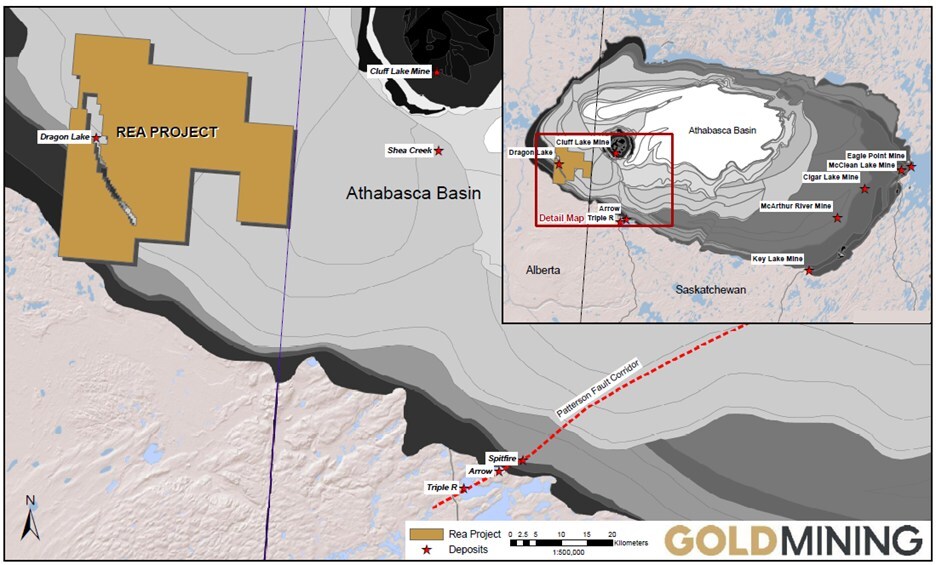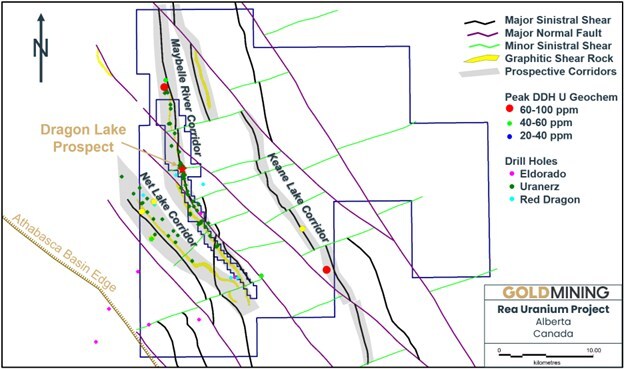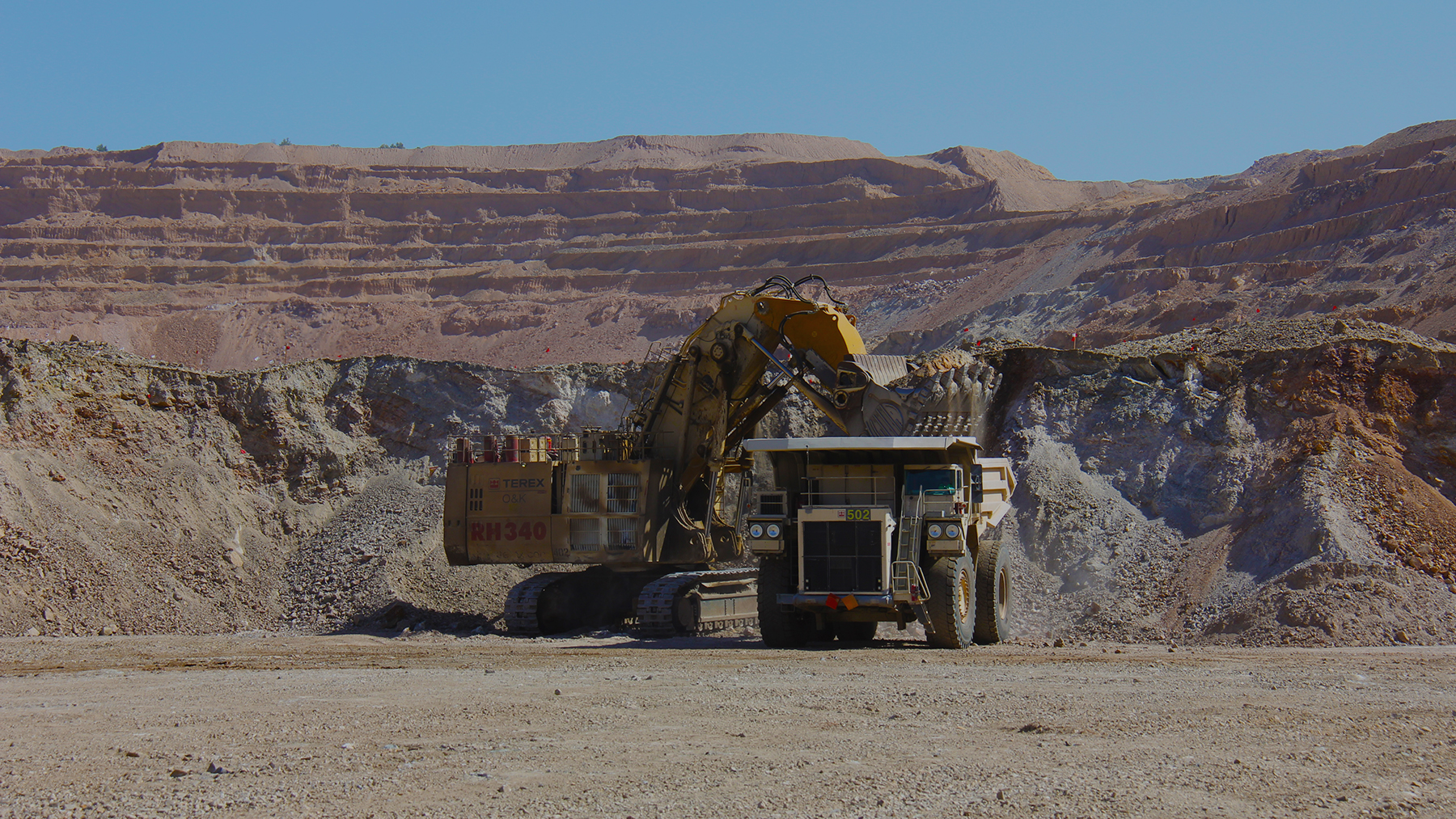(Goldmining, 13.Jun.2024) — GoldMining Inc. reported preliminary results from reprocessing, inversion and modeling of historic geophysical surveys on the Rea uranium project (“Rea Project“), Western Athabasca Basin, Alberta, Canada (see Figure 1). The Rea Project is owned 75% by the Company and 25% by Orano Canada Inc.
The large land package of approximately 125,328 hectares surrounds Oranoꞌs high-grade Dragon Lake prospect at its Maybelle River project. World-class uranium deposits located 60 km to the southeast of the Rea Project include Fission Uranium Corp.’s Triple R deposit and NexGen Energy Inc.’s Arrow deposit, which are currently in development.
Alastair Still, CEO, stated: “The cost-efficient work by our technical team to advance our highly prospective Rea Project is consistent with our strategy of seeking to unlock further value for our shareholders. Our team has applied modern reprocessing techniques, including inversion modelling of the historic geophysical surveys. This work has highlighted the most prospective areas for follow-up exploration, outlined over 70 km within three distinct corridors, each with several target areas displaying geophysical signatures consistent with known Athabasca Basin uranium deposits. We are extremely encouraged by the targets we have generated within the AthabascaBasin, an area that contains some of the world’s largest and highest-grade uranium deposits. This work enhances our activities that have and continue to focus on unlocking value within our portfolio of gold and gold-copper projects located throughout the Americas.”Rea Project Highlights:
- Reprocessing, inversion modelling and reinterpretation of historic geophysical surveys have identified over 70 linear kilometres of basement conductive trends on the Rea Project, interpreted as graphite-bearing shear zones which are prospective for unconformity-style uranium mineralization in the Athabasca Basin, in three northwest trending corridors (see Figure 2):
- The Maybelle River Corridor (11 km) trending northward from Orano’s Maybelle River Project, which hosts shallow high-grade uranium mineralization at the Dragon Lakeprospect.
- Five historic drill holes tested a portion of the Maybelle River Corridor on the Company’s Rea Project claims, intersecting anomalous uranium values in two holes, and anomalous pathfinder elements and pathfinder minerals including clay alteration and dravite, which is a distinctive accessory mineral associated with many major Athabasca uranium occurrences, in three of the five drill holes.
- Five historic drill holes tested a portion of the Maybelle River Corridor on the Company’s Rea Project claims, intersecting anomalous uranium values in two holes, and anomalous pathfinder elements and pathfinder minerals including clay alteration and dravite, which is a distinctive accessory mineral associated with many major Athabasca uranium occurrences, in three of the five drill holes.
- The Net Lake Corridor (20 km) has seen only wide spaced drilling (comprising 20 historic holes), with five holes intersecting anomalous uranium values and associated pathfinder elements and minerals.
- The Keane Lake Corridor (40 km) is largely untested except for two historic drill holes that intersected anomalous uranium values in the south-central area of the Rea Project.
- The Maybelle River Corridor (11 km) trending northward from Orano’s Maybelle River Project, which hosts shallow high-grade uranium mineralization at the Dragon Lakeprospect.
- Each of the three prospective corridors are interpreted as potentially significant and deeply rooted basement structures, which are known to be fundamental to the formation of Athabasca uranium deposits. Drill-proven fault and shear zones have been intersected on both the Maybelle River and Net Lake corridors.
- Follow-up exploration programs are expected to include additional geophysics to refine targets in advance of drilling.


Geophysical Processing, Inversion and Modeling
Unconformity-related uranium deposits in the Athabasca Basin are commonly associated with conductive graphite-bearing shear zones. These zones are located in basement rocks below the basin sedimentary formations and can be detected and mapped via electrical geophysical methods. The shear zones are typically overlain by broad hydrothermal alteration zones in the overlying sandstone. Uranium mineralization is commonly hosted in the sandstone at or near the unconformity, however, there are several deposits such as Fission’s Triple R and NexGen’s Arrow that are hosted within graphitic shear zones in the basement rocks.
GoldMining recently commissioned Fathom Geophysics LLC to process, invert and model historic airborne and ground geophysical surveys that included: Versatile Time Domain Electromagnetics (EM) and magnetic surveys flown in 2005; an Induced Polarization (IP) survey completed in 2006; and a Full Tensor Gradiometry survey flown in 2009. The results of this work were used to manually produce a structural and lithological interpretation consistent with the modelled geophysics and tectonic setting of the Rea Project area (Figure 2).
The Net Lake Corridor (20 km) has been tested by 20 widely spaced drill holes with five of these holes intersecting anomalous uranium and associated pathfinder elements such as vanadium, nickel, cobalt and arsenic, and pathfinder minerals such clay alteration and dravite.
The Maybelle River Corridor (40 km total length, 11 km on Rea Project claims) hosts Orano’s Maybelle River project, which includes shallow (<200 m deep) high-grade uranium mineralization at the Dragon Lake prospect. Dragon Lake, discovered in 1988, has previously reported historic high-grade drill intersections including 17.7% U3O8 over 5 m in MR-39 and 4.7% U3O8 over 1.7 m in MR-34.1 The Maybelle River Corridor extends northwards for 11 km onto the Company’s 75% owned Rea Project claims, where five historic holes have tested only 3 km of the northern extension of the prospective corridor to date. The drilling intersected encouraging anomalous uranium values in two of the holes, as well as clay alteration, breccias and anomalous pathfinder elements in three of the holes.
The Keane Lake Corridor (40 km) is largely unexplored, except for two historic drill holes that intersected anomalous uranium values in the south-central area of the Project.
Please see the technical report titled “Technical Report on the Rea Property, Northeastern Alberta, Canada”, dated effective September 12, 2014, for details on the Rea Project and historic results referenced herein.
| 1 Wheatley, K. and Cutts, C., 2013: Overview of the Dragon Lake Uranium Prospect, Maybelle River Area, Northeastern Alberta, Exploration and Mining Geology, Vol. 21, p 51-62, Canadian Institute of Mining, Metallurgy and Petroleum. |
Qualified Person
Tim Smith, P. Geo., Vice President Exploration of GoldMining, has supervised the preparation of and approved the scientific and technical information contained herein. Mr. Smith is a qualified person defined in National Instrument 43-101 Standards of Disclosure for Mineral Projects (“NI 43-101“).
____________________


